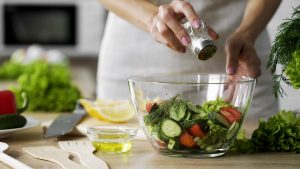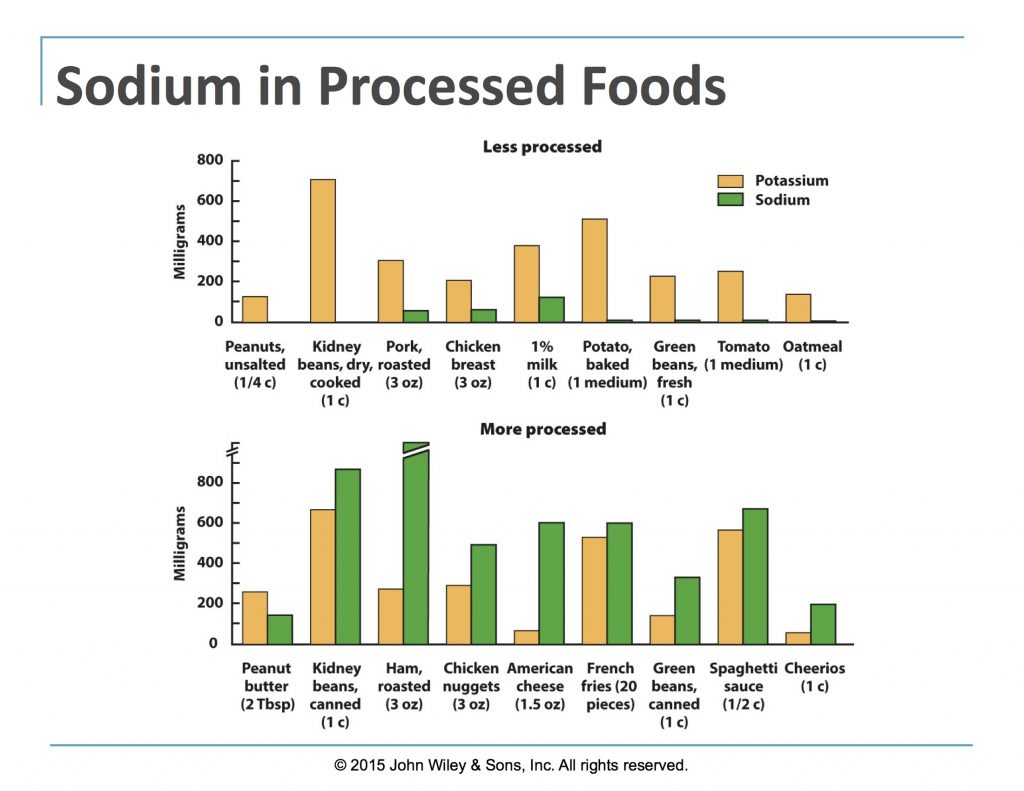
Here’s what you need to know so you can salt your food without getting too much sodium.
The most important thing to remember about salt is that it attracts water. That’s how salt increases our blood pressure. Over time, when we eat too much salt or sodium, it accumulates in our bloodstream. Water than enters our bloodstream to dilute the salt. This creates more blood volume than necessary, creating more pressure when the heart has to move more blood with each pump.
Potassium counteracts this, by keeping more water inside the cells to dilute the potassium. This is a good thing. We need potassium inside the cells for nerve signals and other functions, and we need some sodium outside the cells for the same things. Its the balance that’s key to keeping our blood pressure healthy.
Most Americans are getting almost twice the sodium needed each day, and about half of the recommended amount of potassium. Hence, rampant high blood pressure.
The easiest way to help bring blood pressure closer to normal levels is to cut back on sodium and increase potassium. Potassium is plentiful in fruits and vegetables, as well as seafood and some dairy products. By increasing our consumption of fruits and vegetables we can dramatically increase our potassium intake.
Sodium is found naturally in many foods, although in small amounts. In America, 70% – 80% of the sodium we ingest is from processed foods. Sodium is an effective and inexpensive preservative that also tastes good. So manufacturers use a lot of it.
Here’s the good news:
If we choose fewer processed foods, we have some room in our sodium budget to salt our food to our taste. Much of the salt in processed foods we can’t taste – its just there as a preservative. We do taste the salt we add during cooking or at the table, increasing our enjoyment of our food.
I use this chart with my students to illustrate the sodium levels of popular processed foods:
Cooking Smart
Cooking techniques that maximize salt’s flavor help us keep sodium levels low too. It seems counterintuitive, but salting food during each step of cooking often gives a more developed flavor than just salting at the end.
Salt your meat 20-30 minutes before cooking it, and you will see moisture come out of the meat to dilute the salt, then go back into the meat with the salt and seasoning the meat all the way through. The same principle goes for vegetables, although it takes much less time. Salting your vegetables before placing them in the oven, or salting their cooking water, allows the seasoning to permeate the vegetables all the way to the center.
Think about sautéing onions. Salting them at the beginning draws out their water, then they are ready to absorb flavors like salt, garlic, and any herbs or spices you have cooking along with them.
If a recipe calls for salt, I often add half at the beginning of cooking and half when the recipe calls for it. My food is more deeply flavored, and I have not added any more salt to the dish than I would have normally. (The exception to this rule is baking, always add salt when the recipe says in baking or the chemical reactions may fail.)
Explore some of the newly popular “finishing” salts, like Himalayan Sea Salt (the pink one) or Fleur de Sel or Maldon Sea Salt. The crystals are bigger, so they stay on the surface of the food, lending a little crunch and a burst of flavor. We can use less of these salts to get the same impact. Great flavor, less sodium, and they look great too.
How to Make “No Salt Added” Taste Good
Salting early is especially helpful when using “no salt added” canned vegetables like tomatoes or beans. These are great products – the amount of salt most of us add during cooking is a fraction of the salt usually added to canned foods.
When adding “no salt added” canned beans to a salad, add a little more salt to the dressing than usual and allow the beans to sit in the dressing while prepping the rest of the salad. The salt will flavor the beans more deeply, and the whole salad will taste better.
The “no salt added” tomatoes are a great choice for a sauce. Salt the sauce at the beginning of cooking to let it absorb, then taste near the end for seasoning. If you need to add more, go ahead. Again, you will be saving a lot of sodium and enjoying your food every bit as much as before.
Eating Out
The current guidelines are to limit sodium to 2,300mg per day for most Americans, and 1,500mg per day for those of us with high blood pressure. That’s tough to do if you are eating processed foods, or eating out often at restaurants that use processed foods like cold cuts or prepared sauces.
If you really enjoy eating out, choose menu items that are less processed like salads and entrees without sauces. If you don’t eat many processed foods at home, you have a little more wiggle room.
Be sure to drink water or tea, rather than soda. The sodium levels in soda can be high too, and there is absolutely no health benefit to soda.
I want you to really enjoy your food, and have normal blood pressure. By seasoning our foods throughout cooking, we can deepen flavor and stay within healthy levels of sodium. Cutting back on processed foods means we can use salt where it impacts flavor.
Adding more fruits and vegetables to our day gives us a chance to meet our potassium needs, as well as get nutrients and fiber. They really are all-stars.
Bump up your fruit to 3 servings a day and your vegetables to 4 servings and you will see a difference in your blood pressure and your waistline. Add 1 TBS of ground flax per day (add to oatmeal, yogurt, applesauce, smoothies, etc.) and you can expect a drop in blood pressure similar to many hypertension drugs.
There is no reason high blood pressure has to be a normal part of aging. In societies where processed foods are rare, most seniors have blood pressure close to 110/70. They do not see the hypertension that is so typical in America.
We can do so much better! Reducing sodium intake is one of many things we can do to lower our blood pressure. Exercise, eating well, adding flax to our days, and managing stress all move us toward a lifetime of health.

Leave a Reply